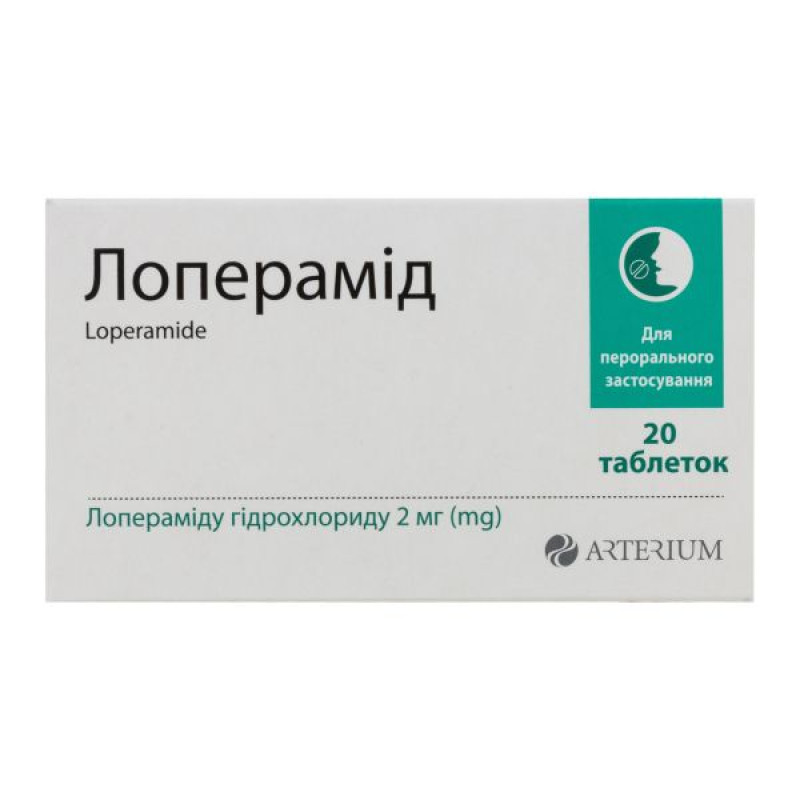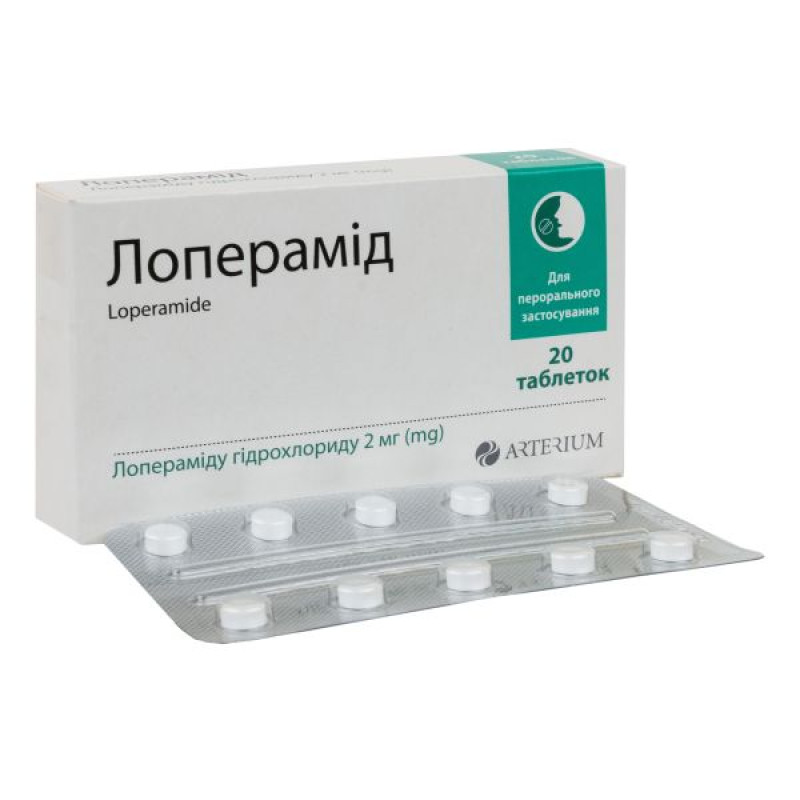Loperamide tablets 2 mg blister No. 20

Instructions Loperamide tablets 2 mg blister No. 20
Composition
active ingredient: loperamide hydrochloride;
1 tablet contains loperamide hydrochloride in terms of 100% substance – 2 mg;
Excipients: lactose monohydrate; potato starch; calcium stearate.
Dosage form
Pills.
Main physicochemical properties: tablets of white or almost white color, round shape, with a flat surface, with a bevel.
Pharmacotherapeutic group
Drugs that inhibit peristalsis.
ATX code A07D A03.
Pharmacological properties
Pharmacodynamics
Loperamide hydrochloride binds to opiate receptors in the intestinal wall, thereby inhibiting the release of acetylcholine and prostaglandins. In this way, loperamide slows down propulsive intestinal peristalsis, and also increases the transit time of intestinal contents through the digestive tract and the ability of the intestinal wall to absorb fluid.
Loperamide hydrochloride increases the tone of the anal sphincter, thereby reducing fecal incontinence and the urge to defecate.
Pharmacokinetics
Absorption: Most of the orally administered loperamide is absorbed from the intestine, but as a result of extensive first-pass metabolism, systemic bioavailability is only approximately 0.3%.
Distribution: There is evidence of a high affinity of loperamide for the intestinal wall with preferential binding to receptors in the longitudinal layer of the muscularis mucosa in rats. Loperamide is 95% protein bound, mainly to albumin. There is evidence that loperamide is a substrate for P-glycoprotein.
Metabolism: Loperamide is almost completely excreted by the liver, where it is mainly metabolized, conjugated and excreted in the bile. Oxidative N-demethylation is the main metabolic pathway of loperamide, this process is mediated mainly by the isoforms CYP3A4 and CYP2C8. As a result of this very intense first-pass effect, plasma concentrations of unchanged drug remain very low.
Elimination: The elimination half-life of loperamide in humans is approximately 11 hours with a range of 9-14 hours. Excretion of unchanged loperamide and its metabolites occurs primarily in the feces.
Paediatric population: There is no information on pharmacokinetic parameters in paediatric patients. The pharmacokinetic behaviour of loperamide and drug interactions with loperamide are expected to be similar to those observed in adults.
Indication
Symptomatic treatment of acute diarrhea in adults and children aged 12 years and over.
Symptomatic treatment of acute episodes of diarrhea due to irritable bowel syndrome in adults aged 18 years and older after initial diagnosis by a physician.
Contraindication
Loperamide is contraindicated:
patients with known hypersensitivity to loperamide hydrochloride or any of the components of the drug; children under 12 years of age; patients with acute dysentery, characterized by the presence of blood in the stool and elevated body temperature; patients with acute ulcerative colitis or pseudomembranous colitis associated with the use of broad-spectrum antibiotics; patients with bacterial enterocolitis caused by microorganisms of the genera Salmonella, Shigella and Campylobacter. Loperamide should not be used at all if it is necessary to avoid inhibition of peristalsis due to the possible risk of significant complications, including intestinal obstruction, megacolon and toxic megacolon.
The drug should be discontinued immediately if constipation, bloating, or intestinal obstruction develops.
Interaction with other medicinal products and other types of interactions
There are reports of interactions between loperamide and drugs with similar pharmacological properties. Drugs that have a depressant effect on the central nervous system should not be used simultaneously with loperamide in children.
There is evidence that loperamide is a substrate for P-glycoprotein. Concomitant administration of loperamide (16 mg) with P-glycoprotein inhibitors (quinidine, ritonavir) resulted in a 2-3-fold increase in plasma loperamide levels. The clinical significance of this pharmacokinetic interaction at recommended doses of loperamide is unknown.
Concomitant administration of loperamide (16 mg single dose) and ketoconazole, an inhibitor of CYP3A4 and P-glycoprotein, resulted in a 5-fold increase in loperamide plasma concentrations. This increase was not associated with an increase in pharmacodynamic effects as measured by pupillometry.
Concomitant treatment with oral desmopressin resulted in a three-fold increase in plasma desmopressin concentrations, likely due to slower gastrointestinal motility.
It is expected that drugs with similar pharmacological properties may enhance the effect of loperamide, and drugs that accelerate the passage of food through the gastrointestinal tract may reduce its effect.
Application features
Treatment of diarrhea is symptomatic. If the etiology of the disease can be determined (or is indicated to be so), then specific treatment should be given if possible.
Patients with diarrhea, especially children, debilitated patients, and the elderly, may develop dehydration and electrolyte imbalances. In such cases, the most important measure is the use of replacement therapy to replenish fluids and electrolytes.
The use of the drug does not replace the administration of an appropriate amount of fluid and restoration of electrolytes.
Since persistent diarrhea may indicate a potentially more serious condition, the drug should not be used for a long time until the cause of the diarrhea is determined.
In acute diarrhea, when clinical improvement is not observed within 48 hours, the use of loperamide hydrochloride should be discontinued and a doctor should be consulted.
Patients with acquired immunodeficiency syndrome who are taking loperamide for diarrhea should immediately discontinue treatment at the first sign of abdominal distension. There are reports of intestinal obstruction with an increased risk of toxic megacolon in AIDS patients with infectious colitis of both viral and bacterial origin, when treated with loperamide.
Abuse of loperamide or its misuse as an opioid substitute has been described in individuals with opioid dependence.
Although pharmacokinetic data are not available in patients with hepatic impairment, loperamide should be used with caution in such patients due to decreased first-pass metabolism. This drug should be administered with caution to patients with hepatic impairment as it may result in relative overdose, which may result in CNS toxicity.
Drugs that prolong transit time may lead to the development of toxic megacolon in this group of patients.
Given the rapid metabolism of loperamide and the excretion of loperamide and its metabolites in the feces, it is usually not necessary to adjust the dose of the drug in patients with impaired renal function.
Since the drug contains lactose, it should not be used in patients with rare hereditary forms of galactose intolerance, the Lapp lactase deficiency or glucose-galactose malabsorption syndrome.
Loperamide does not exhibit pronounced cardiac complications within the therapeutic concentration range. However, at significantly higher concentrations (up to 47 times), loperamide exhibits cardiac complications: inhibition of potassium (hERG) and sodium currents and arrhythmias in animal models in vivo and in vitro.
Cardiac disorders, including QT prolongation and QRS prolongation, and torsade de pointes have been reported in association with overdose. Fatalities have also been reported (see section 4.8). Overdose may precipitate pre-existing Brugada syndrome. Patients should not exceed the recommended dose and/or duration of treatment.
If the drug is taken to control diarrhea attacks due to irritable bowel syndrome, which has been previously diagnosed by a doctor, and clinical improvement is not observed within 48 hours, you should stop using loperamide hydrochloride and consult a doctor. You should also consult a doctor if the nature of the symptoms changes or if recurrent diarrhea attacks last more than 2 weeks.
For the treatment of acute attacks of diarrhea caused by irritable bowel syndrome, loperamide should only be taken if a doctor has previously diagnosed this condition.
In the following cases, the drug should not be used without prior consultation with a doctor, even if it is known that the patient has irritable bowel syndrome (IBS):
the patient is 40 years of age or older and it has been some time since the last IBS attack; the patient is 40 years of age or older and the symptoms of IBS are different this time; recent intestinal bleeding; severe constipation; nausea or vomiting; loss of appetite or weight loss; difficult or painful urination; fever; recent travel abroad.
In case of new symptoms, worsening, or if the clinical condition does not improve within two weeks, you should consult a doctor.
Ability to influence reaction speed when driving vehicles or other mechanisms
Increased fatigue, dizziness or drowsiness may occur in diarrhea syndrome when using loperamide hydrochloride. Therefore, caution is recommended when driving or operating machinery.
Use during pregnancy or breastfeeding
This medicine is not recommended for use during pregnancy. Therefore, pregnant and breastfeeding women should be advised to consult their doctor for appropriate treatment.
Method of administration and doses
Loperamide is not indicated for the initial treatment of severe diarrhoea with reduced fluid and electrolyte levels. In children in particular, it is advisable to compensate for this loss by administering parenteral or oral replacement therapy.
The tablets should be taken without chewing, with water.
Symptomatic treatment of acute diarrhea in adults and children aged 12 years and over
The initial dose is 2 tablets (4 mg), then 1 tablet (2 mg) after each subsequent loose stool. The usual dose is 3-4 tablets (6-8 mg) per day. The maximum daily dose for acute diarrhea should not exceed 6 tablets (12 mg).
Symptomatic treatment of acute attacks of diarrhoea due to irritable bowel syndrome in adults aged 18 years and over after initial diagnosis by a physician
The initial dose is two tablets (4 mg); then take 1 tablet (2 mg) after each loose stool or as previously recommended by your doctor. The maximum daily dose should not exceed 6 tablets (12 mg).
In acute diarrhea, if clinical improvement is not observed within 48 hours, loperamide should be discontinued.
Application for the treatment of elderly patients
No dose adjustment is required for elderly patients.
In case of impaired kidney function
No dose adjustment is required for patients with renal impairment.
Children
The drug should be used in children from 12 years of age for the symptomatic treatment of acute diarrhea.
Overdose
Symptoms.
In case of overdose (including relative overdose due to impaired liver function), central nervous system depression (stupor, impaired coordination, drowsiness, miosis, muscle hypertonia, respiratory depression), urinary retention and a complex of symptoms similar to intestinal obstruction may occur.
Children and patients with impaired liver function may be more sensitive to effects on the central nervous system.
Cardiac abnormalities such as QT and QRS prolongation, torsade de pointes, other serious ventricular arrhythmias, cardiac arrest, and syncope have been observed in individuals who have overdosed on loperamide.
Cardiac arrest and syncope have been reported in individuals who have knowingly taken higher doses of loperamide (doses ranging from 40 to 792 mg/day). Fatalities have also been reported. Overdose may precipitate pre-existing Brugada syndrome.
Treatment.
In case of overdose, the patient should immediately consult a doctor. In case of overdose, ECG monitoring should be initiated. If symptoms of overdose occur, naloxone can be used as an antidote. Since the duration of action of loperamide is longer than that of naloxone (1-3 hours), repeated administration of naloxone may be necessary. The patient should be closely monitored for at least 48 hours to detect possible central nervous system depression.
Adverse reactions
Adults and children aged 12 and over
Adverse reactions in patients with acute diarrhea occurring at a frequency of 1% or more, reported in safety studies of loperamide hydrochloride:
From the nervous system: headache.
On the part of the digestive tract: constipation, bloating, nausea.
Side effects that occurred with a frequency of less than 1% in safety studies of loperamide hydrochloride:
Nervous system: dizziness.
On the part of the digestive tract: dry mouth, flatulence, abdominal pain and discomfort, vomiting, upper abdominal pain, dyspepsia.
Skin and subcutaneous tissue disorders: rash.
Post-marketing experience with loperamide hydrochloride
The following side effects have been observed, which are divided by frequency of occurrence as follows:
very common (≥ 1/10); common (≥ 1/100, < 1/10); uncommon (≥ 1/1000, < 1/100); rare (≥ 1/10000, < 1/1000); very rare (< 1/10000), including isolated reports.
Immune system disorders: very rarely - hypersensitivity reactions, anaphylactic reactions (including anaphylactic shock) and anaphylactoid reactions.
From the nervous system: very rarely - impaired coordination, loss of consciousness, depression of consciousness, hypertonicity, drowsiness, stupor.
On the part of the organs of vision: very rarely - miosis.
On the part of the digestive tract: very rarely - intestinal obstruction (including paralytic intestinal obstruction), megacolon (including toxic megacolon).
Skin and subcutaneous tissue disorders: very rarely - angioedema, bullous eruptions, including Stevens-Johnson syndrome, erythema multiforme and toxic epidermal necrolysis, urticaria and pruritus.
Renal and urinary disorders: very rarely - urinary retention.
General disorders: very rarely - increased fatigue.
Expiration date
4 years.
Storage conditions
Store in the original packaging at a temperature not exceeding 25 ºС.
Keep out of reach of children.
Packaging
10 tablets in a blister, 2 blisters in a pack.
Vacation category
Without a prescription.
Producer
PJSC "Kyivmedpreparat".
Location of the manufacturer and its business address
Ukraine, 01032, Kyiv, Saksaganskoho St., 139.
There are no reviews for this product.
There are no reviews for this product, be the first to leave your review.
No questions about this product, be the first and ask your question.











